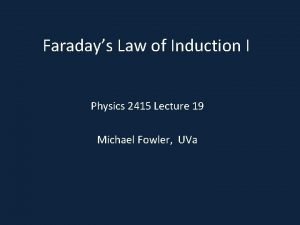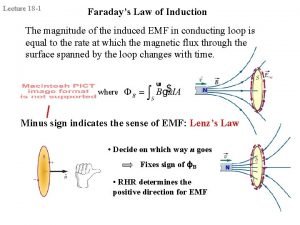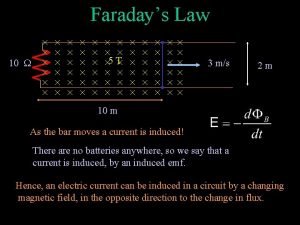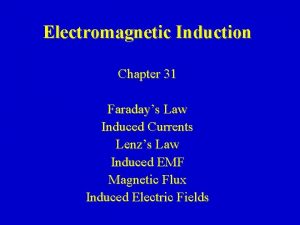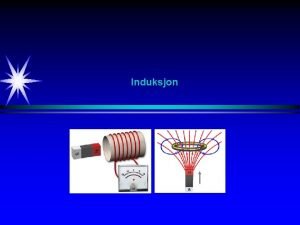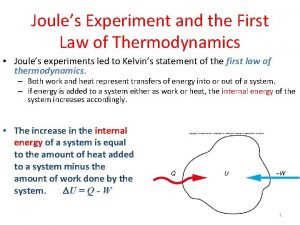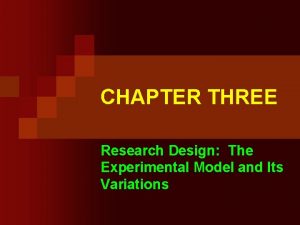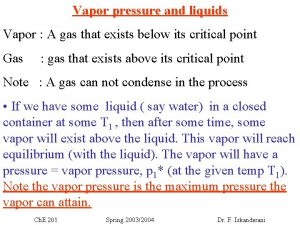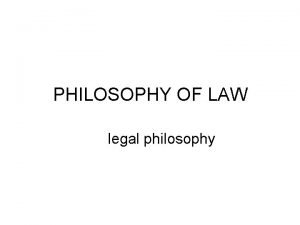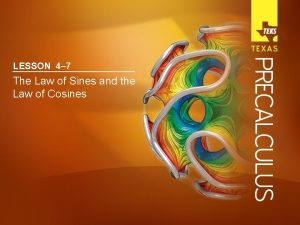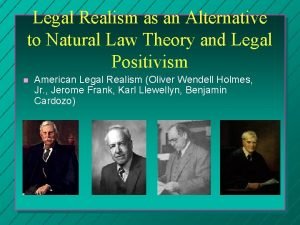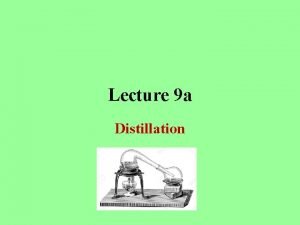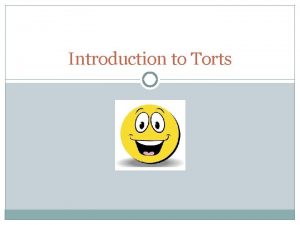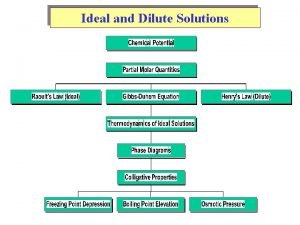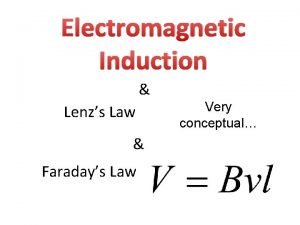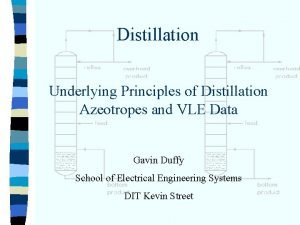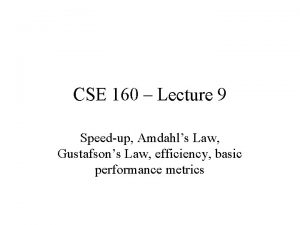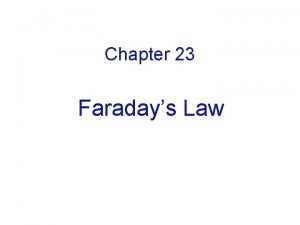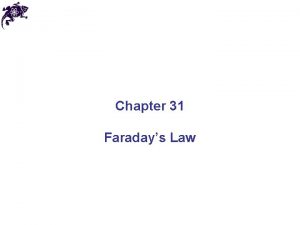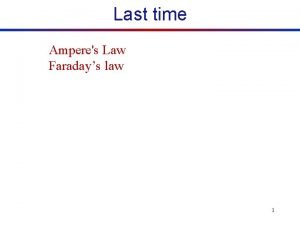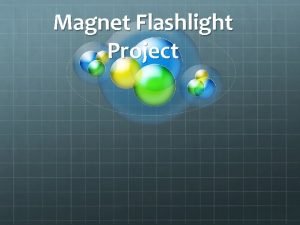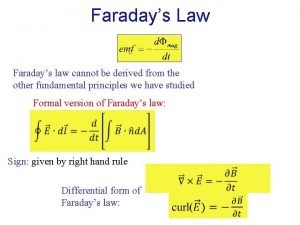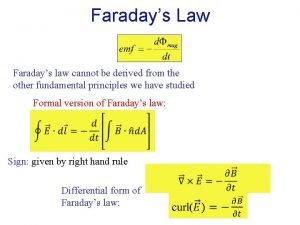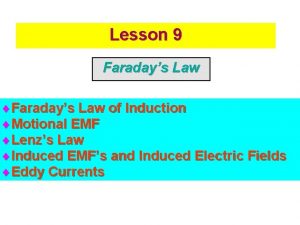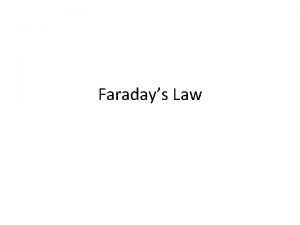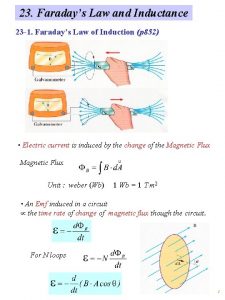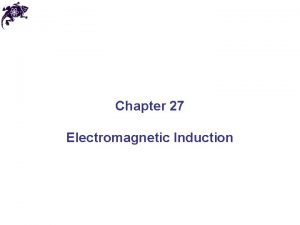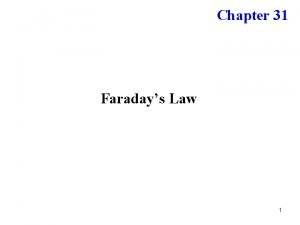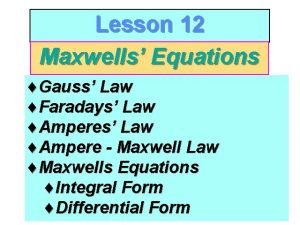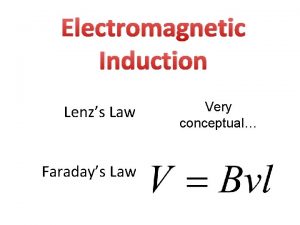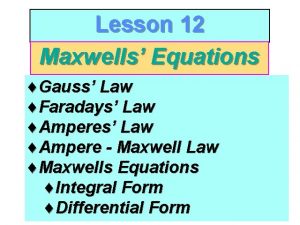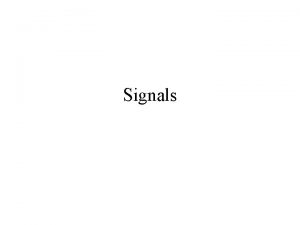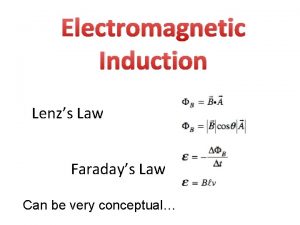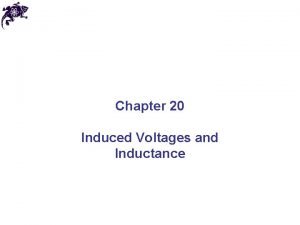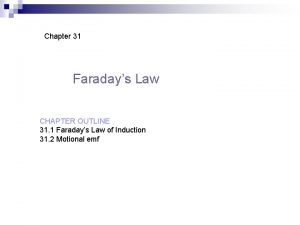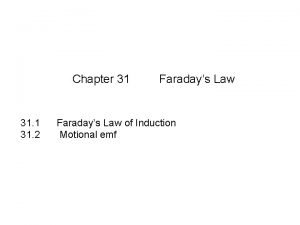Chapter 31 Faradays Law Faradays Experiment A primary



























- Slides: 27

Chapter 31 Faraday’s Law

Faraday’s Experiment • A primary coil is connected to a battery and a secondary coil is connected to an ammeter • The purpose of the secondary circuit is to detect current that might be produced by a (changing) magnetic field • When there is a steady current in the primary circuit, the ammeter reads zero

Faraday’s Experiment • When the switch is opened, the ammeter reads a current and then returns to zero • When the switch is closed, the ammeter reads a current in the opposite direction and then returns to zero • An induced emf is produced in the secondary circuit by the changing magnetic field

Electromagnetic Induction • When a magnet moves toward a loop of wire, the ammeter shows the presence of a current • When the magnet moves away from the loop, the ammeter shows a current in the opposite direction • When the magnet is held stationary, there is no current • If the loop is moved instead of the magnet, a current is also detected

Electromagnetic Induction • A current is set up in the circuit as long as there is relative motion between the magnet and the loop • The current is called an induced current because is it produced by an induced emf

Faraday’s Law and Electromagnetic Induction • Faraday’s law of induction: the instantaneous emf induced in a circuit is directly proportional to the time rate of change of the magnetic flux through the circuit • If the circuit consists of N loops, all of the same area, and if FB is the flux through one loop, an emf is induced in every loop and Faraday’s law becomes

Faraday’s Law and Lenz’ Law • The negative sign in Faraday’s Law is included to indicate the polarity of the induced emf, which is found by Lenz’ Law: • The current caused by the induced emf travels in the direction that creates a magnetic field with flux opposing the change in the original flux through the circuit Heinrich Friedrich Emil Lenz 1804 – 1865

Faraday’s Law and Lenz’ Law • Example: • The magnetic field, B, becomes smaller with time and this reduces the flux • The induced current will produce an induced field, Bind, in the same direction as the original field

Faraday’s Law and Lenz’ Law • Example: • Assume a loop enclosing an area A lies in a uniform magnetic field • Since ΦB = B A cos θ, the change in the flux, ΔΦB, can be produced by a change in B, A or θ

Chapter 31 Problem 17 A coil formed by wrapping 50 turns of wire in the shape of a square is positioned in a magnetic field so that the normal to the plane of the coil makes an angle of 30. 0° with the direction of the field. When the magnetic field is increased uniformly from 200 μT to 600 μT in 0. 400 s, an emf of magnitude 80. 0 m. V is induced in the coil. What is the total length of the wire?

Motional emf • A straight conductor of length ℓ moves perpendicularly with constant velocity through a uniform field • The electrons in the conductor experience a magnetic force FB = q v B • The electrons tend to move to the lower end of the conductor • As the negative charges accumulate at the base, a net positive charge exists at the upper end of the conductor

Motional emf • As a result of this charge separation, an electric field is produced in the conductor • Charges build up at the ends of the conductor until the downward magnetic force is balanced by the upward electric force FE = q v B; E = v B; • There is a potential difference between the upper and lower ends of the conductor

Motional emf • The potential difference between the ends of the conductor (the upper end is at a higher potential than the lower end): ΔV = E ℓ = B ℓ v • A potential difference is maintained across the conductor as long as there is motion through the field • If the motion is reversed, the polarity of the potential difference is also reversed

Motional emf in a Circuit • As the bar (with zero resistance) is pulled to the right with a constant velocity under the influence of an applied force, the free charges experience a magnetic force along the length of the bar • This force sets up an induced current because the charges are free to move in the closed path • The changing magnetic flux through the loop and the corresponding induced emf in the bar result from the change in area of the loop

Motional emf in a Circuit • The induced, motional emf, acts like a battery in the circuit • As the bar moves to the right, the magnetic flux through the circuit increases with time because the area of the loop increases • The induced current must be in a direction such that it opposes the change in the external magnetic flux (Lenz’ Law)

Motional emf in a Circuit • The flux due to the external field is increasing into the page • The flux due to the induced current must be out of the page • Therefore the current must be counterclockwise when the bar moves to the right • If the bar is moving toward the left, the magnetic flux through the loop is decreasing with time – the induced current must be clockwise to produce its own flux into the page

Motional emf in a Circuit • The applied force does work on the conducting bar, thus moving the charges through a magnetic field and establishing a current • The change in energy of the system during some time interval must be equal to the transfer of energy into the system by work • The power input is equal to the rate at which energy is delivered to the resistor

Chapter 31 Problem 24 A conducting rod of length ℓ moves on two horizontal frictionless rails. A constant force of magnitude 1. 00 N moves the bar at a uniform speed of 2. 00 m/s through a magnetic field that is directed into the page. (a) What is the current in an 8. 00 -Ω resistor R? (b) What is the rate of energy dissipation in the resistor? (c) What is the mechanical power delivered by the constant force?

Induced emf and Electric Fields • An electric field is created in the conductor as a result of the changing magnetic flux • Even in the absence of a conducting loop, a changing magnetic field will generate an electric field in empty space (this induced electric field is nonconservative, unlike the electric field produced by stationary charges) • The emf for any closed path can be expressed as the line integral • Faraday’s law can be written in a general form:

Lenz’ Law – Moving Magnet Example • As the bar magnet is moved to the right toward a stationary loop of wire, the magnetic flux increases with time • The induced current produces a flux to the left, so the current is in the direction shown • When applying Lenz’ Law, there are two magnetic fields to consider: changing external and induced

Lenz’ Law – Rotating Loop Example • Assume a loop with N turns, all of the same area rotating in a magnetic field • The flux through the loop at any time t is FB = BAcosq = BAcoswt • The induced emf in the loop is • This is sinusoidal, with emax = NABw

AC Generators • Alternating Current (AC) generators convert mechanical energy to electrical energy • Consist of a wire loop rotated by some external means (falling water, heat by burning coal to produce steam, etc. ) • As the loop rotates, the magnetic flux through it changes with time inducing an emf and a current in the external circuit

AC Generators • The ends of the loop are connected to slip rings that rotate with the loop; connections to the external circuit are made by stationary brushes in contact with the slip rings • The emf generated by the rotating loop:

DC Generators • Components are essentially the same as that of an ac generator • The major difference is the contacts to the rotating loop are made by a split ring, or commutator • The output voltage always has the same polarity • The current is a pulsing current

DC Generators • To produce a steady current, many loops and commutators around the axis of rotation are used • The multiple outputs are superimposed and the output is almost free of fluctuations

Motors • Motors are devices that convert electrical energy into mechanical energy (generators run in reverse) • A motor can perform useful mechanical work when a shaft connected to its rotating coil is attached to some external device • As the coil begins to rotate, the induced back emf opposes the applied voltage and the current in the coil is reduced • The induced emf explains why the power requirements for starting a motor and for running it are greater for heavy loads than for light ones

Answers to Even Numbered Problems Chapter 31: Problem 28 (a) to the right (b) out of the plane of the paper (c) to the right (d) into the paper
 Emf law
Emf law Faraday's law of electromagnetic induction
Faraday's law of electromagnetic induction Emf law
Emf law Faraday's law statement
Faraday's law statement Basic chemistry tutorial
Basic chemistry tutorial Magnetisk fluks
Magnetisk fluks Newton's first law and second law and third law
Newton's first law and second law and third law Newton's first law of motion
Newton's first law of motion Boyle's law charles law avogadro's law
Boyle's law charles law avogadro's law Boyle's law charles law avogadro's law
Boyle's law charles law avogadro's law First law of thermodynamics joule's experiment
First law of thermodynamics joule's experiment Magenta cyan and yellow are the ____ color. *
Magenta cyan and yellow are the ____ color. * Characteristics of experimental research design
Characteristics of experimental research design Raoult's law and dalton's law
Raoult's law and dalton's law Difference between civil law and criminal law
Difference between civil law and criminal law Positive law vs natural law
Positive law vs natural law Natural law vs positive law
Natural law vs positive law Positive law vs natural law
Positive law vs natural law Mendel's law of dominance
Mendel's law of dominance 4-7 the law of sines and the law of cosines
4-7 the law of sines and the law of cosines Positive law vs natural law
Positive law vs natural law Distillation introduction
Distillation introduction Difference between civil law and criminal law
Difference between civil law and criminal law Thermodynamics equations
Thermodynamics equations Gregor mendel data
Gregor mendel data Faraday's law vs lenz's law
Faraday's law vs lenz's law Raoult's law and dalton's law
Raoult's law and dalton's law Gustafson's law in computer architecture
Gustafson's law in computer architecture
